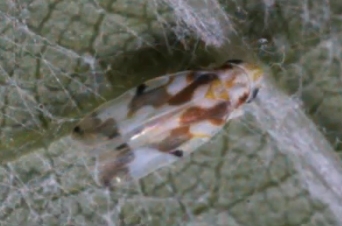UC Blogs
All Cracked Up!
For the past several years, I’ve had problems successfully growing tomatoes bigger than cherry tomatoes. This year was no exception. Whether it was the cool weather or the increasing shade in my maturing yard, my tomatoes would grow and maybe set fruit but the fruit simply wouldn’t ripen. But finally, in September, one variety—Mr. Stripey—showed some promise by turning color. The few I tasted were delicious. Success at last! But then I noticed that each tomato, without fail, had concentric cracks around each stem. Well, this was a disappointing turn of events that I hadn’t seen before.
After a little research, I learned that these cracks, also known as “growth cracks,” are associated with the tomato’s growing conditions. Concentric cracks circle the top of the tomato around the stem while radial cracks extend in a straight line down the side of the tomato from the stem. Both types of cracks are caused when a plant receives too much water after a dry spell, either through excessive watering or after a rainy period. In essence, the plant receives too much water too fast, causing the interior of the tomato to expand too fast for its skin to stretch enough. The skin then cracks to relieve the pressure.
My plants are watered regularly by timed drip irrigation, so I was a little surprised to learn that this system could result in excessive watering (if anything, I’ve been fairly sure that they get under-watered.) But then I learned that some beefsteak-type varieties, like my Mr. Stripey, are prone to cracking. Perhaps that explains it!
Cracked tomatoes are still edible, but are prone to rot or disease setting in quickly. The cracked portion can simply be cut away. In my case, once the cracking appeared, I never was able to beat the rot before picking the tomato.
What can I do to avoid this problem next year? First, try a crack-resistant variety with more elastic skin (e.g., Early Girl, Jet star, Mountain Spring or Mountain Fresh). Second, mulch plants once they are established to help retain soil moisture. Third, pay closer attention to my plants’ irrigation needs, particularly after a hot spell. Although, given my luck with tomatoes lately, I may rethink my summer vegetable garden entirely!
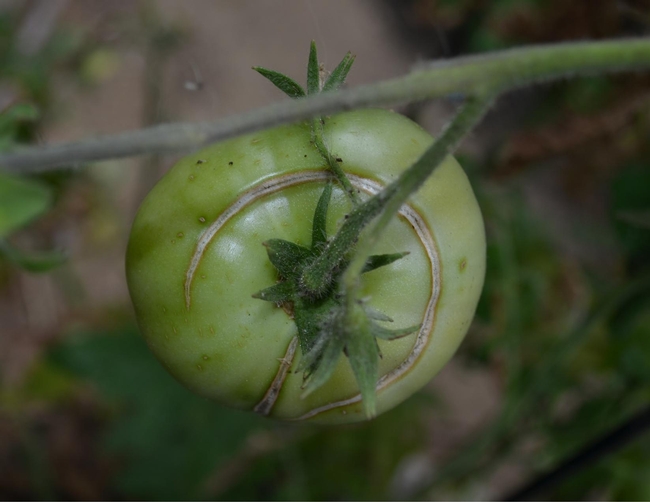
Cracked green tomato, 'Mr. Stripey'. (photos by Erin Mahaney)
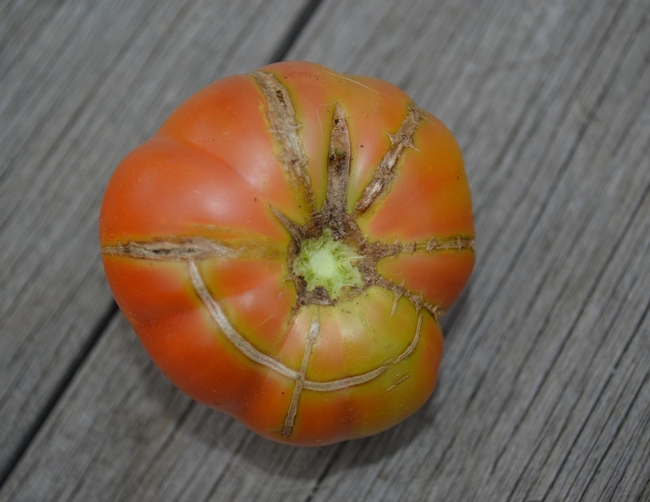
Cracked red 'Mr. Stripey'.
New pest found in California vineyards
The Virginia creeper leafhopper has been found in vineyards from the Oregon border to the northern Sacramento Valley, but so far has not made its way to the storied vineyards of Napa or Sonoma counties, according to an article in The Grower.
Reporter Vicky Boyd based the article on a report by Lucia Varela, UC Cooperative Extension advisor, an integrated pest management expert for the north coast of California. So far, the Virginia creeper leafhopper has been reported primarily in backyard and organic vineyards.
Western leafhoppers are common in California vineyards. Many are controlled by natural enemies. Whether the same will hold true for the Virginia creeper leafhoppers is unknown.
Learn how to distinguish the two leafhoppers by watching the 4-minute UCCE video below.
Fifth annual sheepdog trials in Hopland showcase dogs' skills
Tiffany Revelle, Ukiah Daily Journal
Dog handlers competed recently in the 5th Annual Sheepdog Trials, held on the rolling hills of the UC Hopland Research and Extension Center.
Sheepdog trials are held all over the nation, allowing dogs to accumulate points that count toward a national competition where the top 150 compete for the top spot, bragging rights, and possibly, for money-making opportunities that could include training or breeding, according to Bob Keiffer, superintendent at Hopland.
Just Waiting in the Germander
It's no secret that bees are fond of germanders or Teucrium, a genus in the mint family, Lamiaceae. And it's no secret that praying mantids are fond...
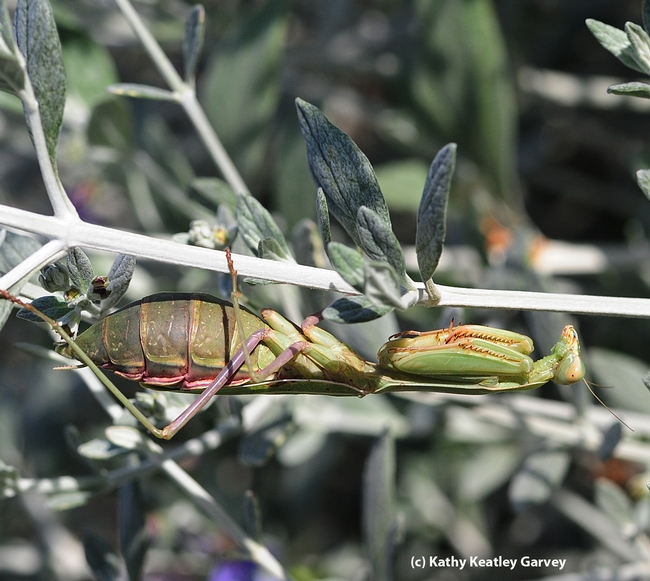
Pregnant praying mantis camouflaged on a germander twig. (Photo by Kathy Keatley Garvey)
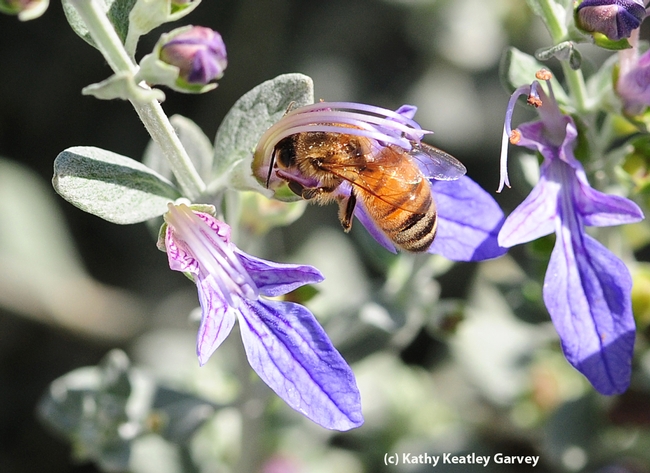
Honey bee nectaring on germander. (Photo by Kathy Keatley Garvey)
A Gathering of Beekeepers
It will be a gathering of beekeepers next week in California. And it promises to be informative, educational and inspiring. Assistant professor...

Bee scientist Brian Johnson of the UC Davis Department of Entomology in front of an observation hive. (Photo by Kathy Keatley Garvey)

Extension apiculturist Eric Mussen of the UC Davis Department of Entomology spends much of his day talking about bees. (Photo by Kathy Keatley Garvey)
What They Did Is Amazing!
If you like Pokémon, you know the insect connection. Satoshi Tajiri of Japan, who developed Pokémon, collected insects in...
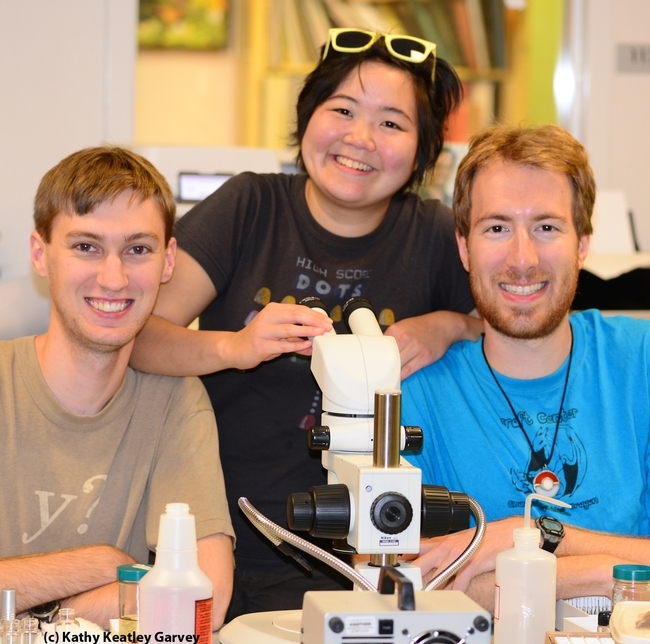
They did it! From left are Andrew Richards, Ivana Li and Matan Shelomi. (Photo by Kathy Keatley Garvey)


